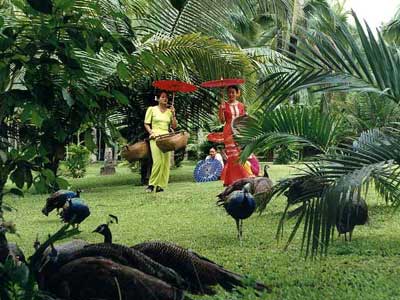 |
|
Man and Nature in Pleasant Harmony |
The survival and development of all ethic groups in Xishuangbanna have close relations with plants. They must contact with plants for their food, clothing and daily uses, and must observe the using methods for all plants. In order to communicate and pass down the information regarding the use of plants, they must give detailed descriptions for the plants they contact, must make it clear whether or not the plants could be used for food, clothing and use, and must describe what the plants look like and where they could be found. In the wake of the increase and accumulation of various information, in order to make communication easier, they must give symbols to plants and must do some basic classification, so that the later generations could use, recognize and find them. The Dai ethic group is the only minority that has letters in Xishuangbanna, and they also enjoy a higher science and cultural level than other minorities. Through accumulation, they find an interesting method for nominating plants. They use the method
"to find differences in similarities and to find similarities in
differences", and thus they established a scientific and practical categorizing system for the plants.
The ancient ballad of the Dai folks expressed their direct feeling in recognizing plants. When it describes the fruits in the forests, it says:
"some are sweet, some are sour; some are red, some are green; and some are big, some are
small". Regarding whether or not fungus is eligible, it says: "chew it in the mouth, those that are not bitter or astringent are
eligible". Among the living creatures, there are plants and animals, but how to tell them? The ballad says:
"those move by wind are plants, and those that shake their tails are
animals", and "animals are more tasty than plants". Among the plants, some live in wild, and some are cultivated; and they differentiate them by dividing them into
"plants on the hills" and "cultivated plants".
In daily practice, the Dai folks use the method of "find similarities in
differences" and classify the plants into two types according to their usages and their living styles. Those classified according to usage include:
(ma) --fruit, (pa) --vegetable, (kao) --grains, (tu)
--beans, (ya) --medicines and (luo) --flowers etc.; those classified according to their living style include:
(mai) --trees (and tall arbor trees) , (ya) --herbs (and shrubs) , (hei)
--vines, (gu) --ficus and (man) --roots etc. Then, they use the method of
"find differences in similarities to nominate plants, for example, cassava, they call it Manniu, man means roots, niu refers to fingers, and it exactly describes the living style of cassava. rubber plant is a kind of plant transplanted to Xishuangbanna later on, based on its characters for producing latex
(yang) , they call it maiyang.
There are also moving stories about the names of some plants. Bamboo orchid is called (nong shang hai) in the Dai dialect and it is a familiar medicine for mitigating poison in the Dai folks. According to the legend, a Dai girl was poisoned and was going to die, her family asked for a moya (doctor); the doctor told them to drink some water boiled with bamboo orchid. Since this plant is quite effective for curing poison, the girl got well upon hearing the name of the medicine.
Since the Dai names for many plants illustrate the usage and living style of the plants, and further explained their special features and biotopes, they made the later generation easier to recognize them in practice. In the countryside, the Dai folks are all quite familiar with the plants around them and could tell their names too. In this way, they cultivate a plant culture, which makes them to live in the rain forests easier.


|

